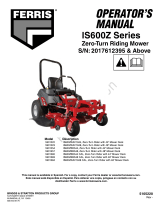
9
6
2. Check the oil level when the unit is cold. The oil should be
up to the "FULL COLD" mark (B). If the oil is below this
level, proceed to step #3.
3. Before removing the tank caps (C), make sure the area
around the tank cap and fill neck of the tank is free of
dust, dirt, or other debris. Remove the tank cap.
4. Add oil up to the "FULL COLD" mark.
5. Reinstall the tank caps.
6. After adding oil to the tanks, it may be necessary to purge
air from the hydraulic system. If the unit is not driving
properly, see your dealer.
Purging the Air from the Hydraulic
System
Due to the effects air has on efficiency in hydraulic drive
systems, it is critical that it be purged from the system.
These purge procedures should be implemented any time a
hydraulic system has been opened to facilitate maintenance
or any additional oil has been added to the system.
The resulting symptoms of air in the hydraulic system may be:
• Noisy operation.
• Lack of power or drive after short term operation.
• High operation temperature and excessive expansion of
oil.
Before starting, make sure the transaxles/transmissions are
at the proper oil levels. If it is not, fill to the specifications
outlined in the Check / Fill Transmission Oil Level procedure.
Purging Air from the Hydraulic System:
1. Chock the front wheels to prevent the machine from
rolling. Raise the rear of the machine so that the vehicle’s
rear tires do not contact the ground. Position jack stands
under the rear bumper of the machine to secure it.
2. Open the transaxle’s bypass valves (see Pushing the
Rider by Hand for the location and function of the bypass
valves), start the engine, release the parking brake, and
slowly move the zero-turn rider’s ground speed control
levers in both forward and reverse directions (5 to 6
times), as air is purged from the unit, the oil level will
drop.
3. Stop the engine and engage the parking brake.
4. Close the transaxle’s bypass valves, start the engine,
release the parking brake, and slowly move the zero-turn
rider’s ground speed control levers in both forward and
reverse directions (5 to 6 times), as air is purged from the
unit, the oil level will drop.
5. Stop the engine. Remove the jack stands from
underneath the machine.
6. Repeat the process detailed above but with the unit's
drive wheels on the ground. The procedure should be
performed in an area free of any objects or bystanders.
It may be necessary to repeat the process detailed above
until all the air is completely purged from the system. When
the transaxles/transmissions operate at normal noise levels
and move smoothly forward and reverse at normal speeds,
then the transaxles/transmissions are considered purged.
Starting the Engine
WARNING
• If you do not understand how a specific control
functions, or have not yet thoroughly read the Features
& Controls section, do so now.
• Do NOT attempt to operate the rider without first
becoming familiar with the location and function of all
controls.
1. While sitting in the operator's seat, make sure that:
• the PTO switch is disengaged,
• the parking brake is engaged, and
• the ground speed control levers are locked in the
START/PARK position.
2. Set the engine speed control past the FAST position to
the CHOKE position.
Note:A warm engine does not require choking.
Note:Some engines are equipped with a separate choke
control.
Note:Some engines are equipped with a ReadyStart®
feature, and do not feature a choke.
3. Insert the key into the ignition switch and turn it to
START.




















